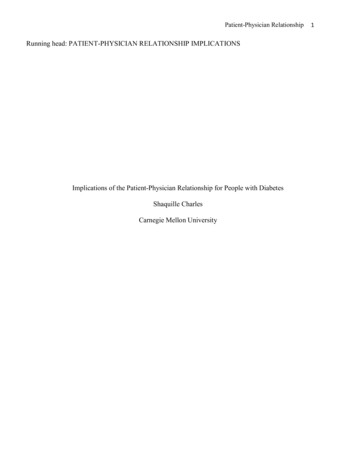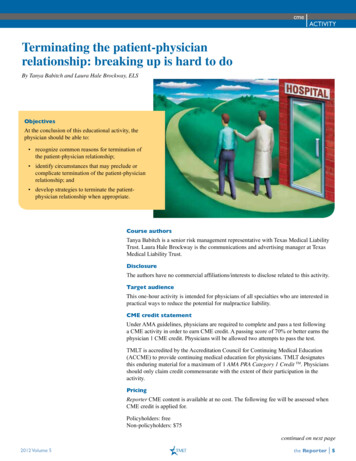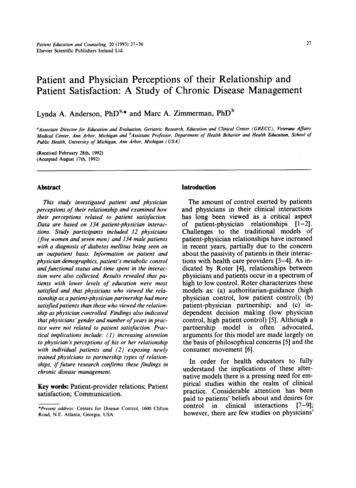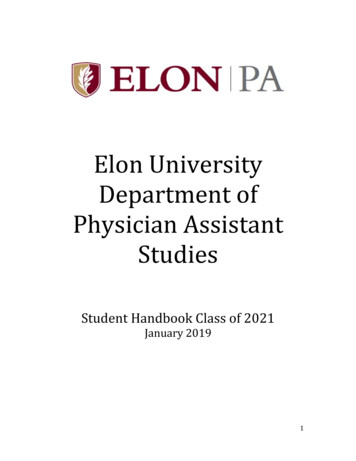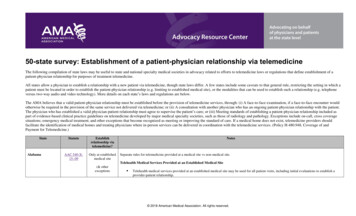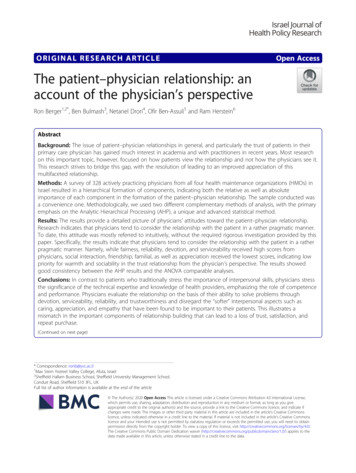
Transcription
ORIGINAL RESEARCH ARTICLEOpen AccessThe patient–physician relationship: anaccount of the physician’s perspectiveRon Berger1,2*, Ben Bulmash3, Netanel Drori4, Ofir Ben-Assuli5 and Ram Herstein6AbstractBackground: The issue of patient–physician relationships in general, and particularly the trust of patients in theirprimary care physician has gained much interest in academia and with practitioners in recent years. Most researchon this important topic, however, focused on how patients view the relationship and not how the physicians see it.This research strives to bridge this gap, with the resolution of leading to an improved appreciation of thismultifaceted relationship.Methods: A survey of 328 actively practicing physicians from all four health maintenance organizations (HMOs) inIsrael resulted in a hierarchical formation of components, indicating both the relative as well as absoluteimportance of each component in the formation of the patient–physician relationship. The sample conducted wasa convenience one. Methodologically, we used two different complementary methods of analysis, with the primaryemphasis on the Analytic Hierarchical Processing (AHP), a unique and advanced statistical method.Results: The results provide a detailed picture of physicians’ attitudes toward the patient–physician relationship.Research indicates that physicians tend to consider the relationship with the patient in a rather pragmatic manner.To date, this attitude was mostly referred to intuitively, without the required rigorous investigation provided by thispaper. Specifically, the results indicate that physicians tend to consider the relationship with the patient in a ratherpragmatic manner. Namely, while fairness, reliability, devotion, and serviceability received high scores fromphysicians, social interaction, friendship, familial, as well as appreciation received the lowest scores, indicating lowpriority for warmth and sociability in the trust relationship from the physician’s perspective. The results showedgood consistency between the AHP results and the ANOVA comparable analyses.Conclusions: In contrast to patients who traditionally stress the importance of interpersonal skills, physicians stressthe significance of the technical expertise and knowledge of health providers, emphasizing the role of competenceand performance. Physicians evaluate the relationship on the basis of their ability to solve problems throughdevotion, serviceability, reliability, and trustworthiness and disregard the “softer” interpersonal aspects such ascaring, appreciation, and empathy that have been found to be important to their patients. This illustrates amismatch in the important components of relationship building that can lead to a loss of trust, satisfaction, andrepeat purchase.(Continued on next page)* Correspondence: ronb@yvc.ac.il1Max Stern Yezreel Valley College, Afula, Israel2Sheffield Hallam Business School, Sheffield University Management School,Conduit Road, Sheffield S10 3FL, UKFull list of author information is available at the end of the article The Author(s). 2020 Open Access This article is licensed under a Creative Commons Attribution 4.0 International License,which permits use, sharing, adaptation, distribution and reproduction in any medium or format, as long as you giveappropriate credit to the original author(s) and the source, provide a link to the Creative Commons licence, and indicate ifchanges were made. The images or other third party material in this article are included in the article's Creative Commonslicence, unless indicated otherwise in a credit line to the material. If material is not included in the article's Creative Commonslicence and your intended use is not permitted by statutory regulation or exceeds the permitted use, you will need to obtainpermission directly from the copyright holder. To view a copy of this licence, visit http://creativecommons.org/licenses/by/4.0/.The Creative Commons Public Domain Dedication waiver ) applies to thedata made available in this article, unless otherwise stated in a credit line to the data.
Berger et al. Israel Journal of Health Policy Research(2020) 9:33Page 2 of 16(Continued from previous page)Policy implications: We study the impact physicians’ incentives have on the tangible relationship and discuss thesignificance of physician-patient relationship on satisfaction with the health service given. As a result policiesleading to a more dynamic role must be given to the patient, who being well informed by the physician, can helpin the decision making process. Policy schemes need to be implemented as a way of changing physicians’behavior, forcing them to better construct and utilize this dyadic relationship.Keywords: Patient–physician relationship, Social exchange, Pragmatism, Trust, Reciprocity, Benevolence, Medicalrelationship, Analytical hierarchic processingIntroductionBusiness relationships are characterized by having“service providers” and “service receivers”. In thehealth care service, the service providers are considered as having more power in the dyadic relationshipthan other types of services. This is due to theasymmetrical nature of the relationship, in which thereceiver faces or perceives a high degree of complexity in the medical service being given. Trust, a keyfactor in the relationship between the service provider and the service receiver and is also unique inthe health care service context. It is considered responsible for the placebo effect, for the effectivenessof alternative medicine, and for the inexplicable variations in the way patients respond to conventionaltherapies [1], furthermore there is much researchundertaken today in the field of alternative / complementary medicine such as the National center forComplementary and Integrative Health.Some researchers examined what constitutes a goodphysician [2–4]. It is understood that physicians’ technical knowledge and the skills are not sufficient indicators of performance in the eyes of patients [5–7].To be a good or appreciated physician or perceivedas one, it is important to have good interpersonalskills that establish strong, trust-based physician–patient interactions [8–10]. There is ample evidence thatpatients seek a strong relationship with their primarycare physician as a result of their need for dependency and lack of knowledge [11–14].In the past, the importance of the patient–physicianrelationship did not get much attention from health caredecision makers [15–17]. Today, however, health careservices and physicians perceive and refer to thisrelationship as a strategic marketing tool for three mainreasons. Firstly, in the current competitive milieu, physicians’ financial success depends on their patients’ repeatbusiness and referrals, resulting in fierce competition asis common in many other industries [5]. Secondly, patients view this service as a credence service, which ishard to evaluate objectively. As such, trust emerges asan important factor in building a strong and healthyrelationship [18, 19]. Thirdly, medical research hasshown that a strong relationship between the physician and the patient increases the success of themedical service given [20–22].Traditionally, the patient–physician relationship hasbeen structured around the concept of what can becalled the ‘clinical model’, which is utilitarian and teleological in its understanding of the mutual bond. Thepatient is seen as having a disease produced by either anexternal factor or a malfunctioning structure that is thesource of pain and unhappiness. The recognition andtreatment of this disease, if successful, will restore thepatient’s well-being. This clinical underscores much ofmainstream medical practice [23]. The ‘relational model’,in contrast, focuses on the quality of the process of thepatient–physician interaction. Replacing the physician’srole of being an expert providing technical expertise andknowledge to the patient who passively accepts, therelationship now becomes a partaking one for bothplayers in the framework of which they exchange information [24]. The patient is transformed from apassive bystander into an active and integral participant in the healing process. In any joint relationship,and especially with a credence type of service, communication leading to mutual trust is a crucial element in the success of the interaction [25].The business of medicine has shifted to concentrateon profit and technology utilization and, in parallel, tocultivating the relationship between patients and physicians to increase consumer satisfaction and maintainprofits [26]. Health care costs are rising alongside acommensurate decline in patient satisfaction [27] anda growing number of complaints. Most patients’ complaints do not relate to health skills, but to ineffectivecommunication. Most often, patients protest that physicians do not pay attention to their needs. Patientswant more information about their problem and treatment outcomes, guidance on what they can do forthemselves, more information on treatment sideeffects, and to be an active participant in the healingprocess [28–30].To gain further insights into the dyadic physician–patient relationship, the focus of this research investigatesthe factors influencing relationship formation from the
Berger et al. Israel Journal of Health Policy Research(2020) 9:33physician’s perspective. The flow of the article is as follows. We begin by discussing the foundations of socialrelationship formation in the medical field and discussits importance. These foundations are interrelated andinclude benevolence (affective ties), honesty (trust), andreciprocity, leading to satisfaction from the mutual relationship. This is followed by a description of theresearch methodology, research tools and findings.Lastly, in the Conclusion section, we discuss the differences in relationship formation between physicians andpatients, and how this relationship can be better structured to facilitate better treatment resulting in mutualsatisfaction. Although this research focuses only on howphysicians view the relationship, using published works,we illustrate how patients see this relationship and thencompare and contrast the two views to get a moreholistic picture.Literature reviewMedical diagnosis determined by the physician is a complex, bio-psycho-social one [5, 31, 32] hence, to understand the whole, the components need to be understoodtoo. Since patients and physicians often disagree on whatis perceived as “good health service” [33, 34], the goal ofour study is to assess the most important aspects of thepatient–physician relationship from the perspective ofthe physician and compare it to the views of the patients(based on existing literature). Utilizing this comparison,we can shape a more holistic view of this dyadic bond.Notably, if each party refers to different aspects of therelationship and defines it in their own way, it is essential to bridge this gap between the parties’ perceptions inorder to build a stronger relationship, leading to bettertreatment outcome.Identifying the constructs patients use when makingphysician choice decisions, and especially their evaluations of subjective quality-related choice criteria, is of increasing importance to the health care business [22].This is because the role of the patient in the hospitaland physician selection process has grown. The increasein customer choice and the inherent complexity of themedical facility choice process have become more apparent, especially with increased privatization and the profitorientation view [34]. Accordingly, to better understandand align this relationship, physicians’ views must beexamined.A variety of studies have shown that physicians andpatients have different views regarding what might be effective communication between them. These views influence the perceived quality of the medical servicerendered (Berger et al., [35]). Acquiring communicationskills in times of change and uncertainty can lead to acompetitive advantage. Medical educators should use patient–physician perceptions of care and focus on thePage 3 of 16areas of teaching that will help practitioners to meet patients’ expectations. Table 12 summarizes the differencesin views of what is considered good medical service (seeAppendix C).No doubt that the asymmetries noted in the patientphysician relationship is derived mainly from the differences in health seeking behavior, and use of the internet.According to Moorhead et al. [36] several key ways thatsocial media are being used today in healthcare: to provide information on a range of issues; to provide answersto medical questions; to facilitate dialogue between patients and health professionals; to collect data on patientexperiences and opinions; to use social media as a healthintervention, for health promotion and health education;to reduce illness stigma; and to provide a mechanism foronline consultations. Thus, these diversified ways increase availability of health information but at the sametime increase variety of opinions some objectives andsome subjective.Initially, medical journals focused on the medical actitself: interventions, hospitalization and the administrative side [37, 38]. Later, these journals started studyingnon-medical factors such as patient–physician relationships, organizational climate, and benefits provided byhealth providers outside the strict health services given[39, 40]. Over time, the patient–physician bond hasevolved because of such developments as improved patient involvement in the medical procedures and doctorand/or facility choice, while reducing the passive acceptance of therapeutic indications as is. Patients’ responsibility regarding their own well-being has increased aswell as the degree of information they have. Their demand for more knowledge and involvement from theirphysician has also grown. Numerous scholars have argued that traditional, symptomatic-oriented medicine isbeing replaced by patient-centered medicine where thephysician invests more time on the patient’s problemsand not only medical but also psychological and socialones. It was found that most patients want an active collaborative and humane involvement in the managementof their own illness [16].One study that examined the perspective of both parties was that of Krupat et al. [41], which was more qualitative in nature. The study indicated that from theperspective of patients, trust was established whenpower and information were shared by physicians,whereas physicians were apparently less affected by theseaspects shaping patients’ attitudes. We claim that suchincongruence may cause mistrust between patients andphysicians, and lead to misunderstandings. The studyfurther claimed that from the physicians’ perspective,the patient–physician relationship is rational and practical in nature. Again, this rational view by physicians isincongruent with the patients’ view, which is subjective
Berger et al. Israel Journal of Health Policy Research(2020) 9:33in nature, emphasizes information sharing and empathyand takes into account their emotional state [1]. Thus,while Bendapudi et al. [2], who focused on the patient’sperspective, claimed in their qualitative research thatphysicians’ openness to sharing with their patients in anempathic manner all aspects of information collectedleads patients to trust their physicians more, physiciansmay define this relationship with their patients onesidedly. They provide their patients with informationbased on rational indexes and less on emotional indexesand data, an area with which they may feel less conferrable with—a point that needs to be further explored.In many service contexts and especially in the medicalindustry, customers do not know the appropriate level ofservice required for their specific needs [42]. They relyon the advice of an “expert” who typically also providesthe subsequent service. For example, the HippocraticOath of a physician controls for the problem of undertreatment in the medical services. The separation of physicians and pharmaceutical and other medical serviceproviders is intended to circumvent overtreatment byunravelling the motivations to prescribe medications andmarket medical facilities from the revenue made by selling them. There is a continuing discussion in the healthcare literature about the presence of physician-induceddemand [43]. Physicians may offset the drop in the number of customers by a rise in the scale and scope of caredelivered in each encounter. For instance, research hasshown that the incidences of cesarean deliveries compared to standard child births are linked to the remuneration differences of health insurance policies [44].Medicine has become like any profit-oriented business,serving markets rather than patients, and focused onthroughput rather than patient-centered care. This ishighlighted in the CNN headline, “Patients give horrorstories as cancer physician gets in 45 years” [45]. Conflicts of interest are accountable for an abundant amountof ethical wrongdoing [27]. Defensive medicine is another important issue in medical services. This term refers to physicians ordering tests and procedures, makingreferrals or taking other steps to help protect themselvesfrom liability rather than to benefit their patients’ care[46]. This certainly results in the “overuse of medicalservices” solely to ensure that the physician is protectedfrom a malpractice lawsuit. As a result, it is very difficultfor a patient to assess if he or she is getting the rightamount of medical care or is over- or under-treated. It isimportant to note that it is also very difficult to assessthe gap, if one exists, between the level of treatmentneeded to the one given ad hoc or post hoc, thus increasing the perceived risks.Value from a service rendered is frequently fashionedwithin the setting of the supplier–buyer relationship[47]. Relational significance is considered as thePage 4 of 16professed net worth of the tangible benefits that emergeover the period of the relationship [48]. Some goods andservices, due to their complexity, can mainly be deliveredwithin the framework of a relationship where the buyeris compelled to trust the supplier, which is characteristicof the medical service industry [49]. Medical treatmentsoffer the most complicated and maybe the most important environment within which trust should foster. Formany diseases, no satisfactory treatment exists, withothers success is only random. Thus, a failing treatmentis no perfect signal of under- or over-treatment. Thesetypes of goods and services are called “credencegoods”—goods/services whose quality when renderedcannot be measured even after their receipt [50].Credence goods are goods and services traded within interactions categorized by high levels of information asymmetry, where it is the supplier who regulates the buyer’sneeds [51]. Many professional services have the attributesof credence goods, as they are often customized [52], requiring intensive interaction from both parties to createvalue [53]. Quality can neither be hypothesized norassessed by customary approaches because of credencegoods’ three characteristics: heterogeneity, intangibilityand inseparability [51]. The key feature of credence goodsis that consumers do not know the quality of a good orservice they need or are receiving before purchasing, during its usage, or after receiving it. Perceived quality ofmedical treatment must, accordingly, be based on nonobjective cues such as perceived trust based on the dyadicrelationship created, word-of-mouth, the way a physicianapproaches the patient, diplomas, and how the physician’sfacilities look. Medical services are often considered highrisk purchases, given that the level of uncertainty and perceived risks are the highest [54]. Mitra., et al. [49] recognized that customers of credence goods endure thiscomparatively higher level of risk by constructing relationships and spending more time searching for informationabout the good providers than customers of search or experience goods. The mutual relationship model presentedbelow elucidates this symbiosis.The potential impact on credence goods can be seenin the results of a field experiment in the market fordental care of Gottschalk et al. [55] where an overtreatment recommendation rate of 28% and a striking heterogeneity in treatment recommendations was observed. Itwas found that mainly dentists with shorter waitingtimes are more likely to propose unnecessary treatmentthan others. Since patients are often left to use price asthe only signal of quality, it is crucial to encourage patients to rely on recommendations from other users.The research modelThe relationship exploration model is commended as aresearch approach to circumvent service imperceptibility
Berger et al. Israel Journal of Health Policy Research(2020) 9:33[56] and is suitable for exploring credence services [57].Recent research has illustrated that social relationshipsare not a single-dimensional concept [58]. Instead oftreating service provision as a discrete event (i.e., a oneoff transaction), social exchange theory suggests treatingthis service as an ongoing relationship. The developmentof relationships is an intensive process that is costly,time-consuming, and does not necessarily generate animmediate result. To explore the individual relationalconstructs that together build a better picture of what isseen as a good quality relationship, we utilize the multidimensional GRX scale [59]. The scale consists of threemain constructs: (1) benevolence (i.e., mutual feelings);(2) reciprocity; and (3) trust (i.e., trust that one will dowhat has been promised and that one has the ability todo what was promised). Each construct is broken downinto sub constructs, as presented by Yen and Barnes[60], which facilitate better understanding of the issues,as presented in Fig. 1. The GRX scale has been usedextensively to measure the quality of social relationshipsin many areas, for example, organizational capabilities[58], leadership [61, 62], service quality in hospitalitymanagement [63–65], business ethics [66], and customerrelationships [67]. It has been further utilized incountries such as China, Russia, India, and Arab countries. A strong social relationship was found to be basedupon three constructs [68]. The first construct is theFig. 1 The Research ModelPage 5 of 16confidence that the relationship partner will act benevolently to the advantage of the relationship [69]; the second is that the partner will behave honestly and can betrusted to be competent in his or her role [70]; and thethird is that the partner will reciprocate the trust given,creating a long term relationship [71].Research has shown that social relationship quality isviewed as a higher order construct comprising multipleconstructs [9, 72]. When a customer feels that she isinvolved in a high quality relationship, she will be satisfied with the service performance and is able to rely onthe service provider [42]. According to Parsons (2002),a strong relationship refers to the degree to which theperformances meet customers’ expectations. Recall thatin the medical profession, it is almost impossible tomeasure objectively the quality of service given, as it isa credence good [73]. This means that even after theservice is rendered and the patient did not die or sufferadverse side-effects, it is impossible to determine that ifthe service had been given by another physician, theoutcome could have been better. Furthermore, in manycases it takes years for side-effects to become apparent.As a result, the only way to examine satisfaction in themedical field is the patient’s perceived satisfaction, inmany cases based on a personal view of the outcome.The following is the discussion of the constructscomprising our model.
Berger et al. Israel Journal of Health Policy Research(2020) 9:33Benevolence (affective tie)Benevolence represents feelings and affection, a type ofan emotional attachment that signals the quality of therelationship. It is claimed that in the medical industry,knowing the patient is at least as important as knowingthe disease [9]. It is claimed that physicians with a warmand friendly style are more effective than physicians witha more formal style [74]. Empathy could be viewed as anaspect of medicine’s sacred commitment to stand withthe sick, and the fragility of existence. It is triggered by aneed for companionship and mutual understanding, especially during this exposed and unbalanced relationship. Benevolence has been found to intensifysatisfaction amongst exchange partners [58]. Hence, apatient–physician relationship that demonstrates benevolence is thought to lead to better perceived care andgreater patient–physician satisfaction, leading to a longterm relationship [16].TrustTrust implies credibility and, by increasing trust, onecan improve relationships and increase mutual cooperation. As a rule, the patient’s trust in a physician isconnected to one’s illness-generated vulnerability situation. It has been generally acknowledged that in situations in which there is a high level of perceived risk,creating trust in the service provider’s abilities necessitates a greater dependence on personal sources of information (such as friends and relatives) rather than viaimpersonal sources [22]. Trust in the patient–physicianrelationship is akin to the trust displayed in the familycell. This relationship has a robust affective and emotional dimension [43]. Trust is a necessary condition formedical practice; it is the “fundamental moral law formedicine” [75]. In the past, the trust of families and patients in a physician was imbedded. Today, trust is seenas something that is built gradually through a number ofexchanges, and families and their patients are seen as active contributors in the service given based upon thecapacity to manage, observe, and evaluate various circumstances concerning their health situation [76].We define trust as prevailing when one actor has assurance in the exchange regarding the other actor’s integrity and reliability. This is when, for example, thephysician can be relied upon to deliver on his promises[77]. Mutual trust in the medical profession is seen as akey relational building block. According to Hall et al.[78], trust is seen as significant in its own right becauseit is the construct that gives medical interactions intrinsic value. Trust can be seen as the willingness of oneparty to be vulnerable to a particular action that is important to the trustor, irrespective of the ability to monitor or control that other party’s actions [79]. Over theyears, numerous researchers highlighted the need forPage 6 of 16trust in the health industry and stressed the importancethat the patient has faith in that the physician will lookout for the patient’s interests [78].Trust is critical to patients’ willingness to seek care,reveal sensitive information, submit to treatment, andfollow physicians’ instructions/recommendations [80].Previously, the belief was that a comprehensive understanding and trust can only be built up over timethrough a close relationship that went beyond an understanding of the medical needs of each patient. Today,trust is viewed as a fundamental building block in themedical process. Trust is developed through repeated interactions in which the patient and one’s family observethe physician and decide if he is consistent, competent,honest, fair, responsible, and benevolent. Through engaging in actions that demonstrate honesty and extra effort, the patient develops trust in his physician [81].Being able to measure trust is vital for physicians because it enables them to better monitor and evaluate thetrust that is integral in building a strong health systemwith better health and economic outcomes [82]. Trustseems to work like a prognosticator of the endurance ofa relationship between a certain patient and a certainphysician. It can be seen as a motivating cause for increased adherence to wide-ranging medical instructionsand recommendations related to the treatment, self-careactions and the inclination to pay attention to health ina sustained and continual method.ReciprocityResearchers are increasingly focusing on definingphysician-to-patient communication to show that itplays a significant role in creating customer satisfactionand improving perceived quality of medical servicesgiven [22]. Dealing in uncertainty, risk, and the impossibility of generating a definition for the situation thatwould result in a solution for health creates the basisfor the patient’s need to trust the medical system. Ithas been established that reciprocity is an importantkey construct in building a fruitful patient–physicianrelationship [83]. Reciprocity is when one gets compensated for one’s honesty and professionalism by, forexample, repeat business and referrals [58]. This is auseful mechanism to achieve better co-operationbetween both parties. Even if only one member of thedyad breaks this reciprocal relationship, both parties’interests may be damaged [59]. Reciprocity, in our context, means matching the differing viewpoints of thepatient–physician communications. Given that credenceservices are seen to constitute high risk purchases [57],this would logically imply that the reciprocity constructwould take on greater significance in the evaluation ofmedical services. Most health service providers identifythe significance of building more sustainable and long-
Berger et al. Israel Journal of Health Policy Research(2020) 9:33lasting relationships with their patients [77]. Very often,increased customer loyalty and repeat purchases are argued to be the single most important driver of a firm’slong-term financial performance and the medical industry is no different. We believe that if the physicianwould go that “extra mile” for the patient, the patientwould rec
patients seek a strong relationship with their primary care physician as a result of their need for depend-ency and lack of knowledge [11-14]. In the past, the importance of the patient-physician relationship did not get much attention from health care decision makers [15-17]. Today, however, health care


